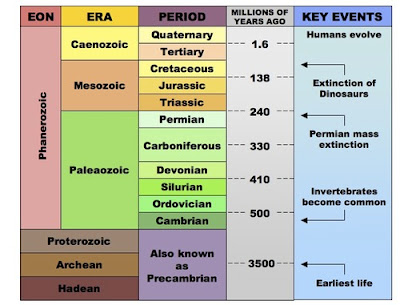As we discovered last week, Earth itself was formed about 4.5 billion years ago from the aggregation of all sorts of things circling the sun: rocks, dust, molecules, chunks of ice, and so forth. The early Earth was one big explosion -- or actually, a whole series of smaller explosions, as debris collided with the forming planet. It was hot, very active, and prone to sudden impacts. After about a few hundred million years, things had calmed down enough for the new planet to start to resemble, however remotely, the Earth we all know and love.
There were some significant differences: it was extremely active seismically and it was bombarded by heavy, lethal radiation from the sun because there was no free oxygen. All the oxygen was tied up in carbon dioxide, water, and other oxides, so the atmosphere was not only not breathable, there was no ozone layer to shield the Earth from the sun's radiation.
 |
| Hadean Earth |
This eon is known as the Hadean, for obvious reasons: Earth was a sort of hellish place at that point, but very soon it rained. And rained. And rained. And thus we had oceans, and then things started cooking. So to speak.
OK -- so how on Earth, then, did life happen?
 |
| Modern stromatolites in Shark Bay, Australia; photo UC Berkeley |
The first evidence we have of living organisms are fossils dating to about 3.5 billion years ago, from microfossils -- which are just what it sounds like, fossils to small to be seen without a microscope, and structures known as stromatolites, which are produced by colonies of microorganisms that trap sediments and build up structures like those pictured at the left. The show-stopper is that these microorganisms were mostly cyanobacteria, which had already developed the ability to photosynthesize -- using energy from the sun to convert carbon dioxide and water to simple sugars and oxygen. So already, we have life and free oxygen in the atmosphere.
To be honest, no one is quite sure how living organisms happened. There are several schools of thought on this; you can get an overview of several of them
here, but I'm going to stick to the two or three that seem to have the most current support. (Well, mostly support from me.)
One theory that's very popular is that life came from outer space on the meteorites that had been, and continued to bombard the planet, in the form of organic molecules. It doesn't really answer the question of how, but assumes that life already existed. This is proposed as an alternative to the idea that organic molecules were formed through the action of lightning on what has been called the "primordial soup" -- a mix of methane, ammonia, water, carbon dioxide and other hydride molecules that made up most of the early atmosphere. (Based on the
Miller-Urey experiment of 1952.) Another alternative is that these molecules originated around deep sea vents (remember, the earth was practically one big volcano at this point), which even today support ecosystems that are based on sulfides dissolved in superheated water jetting from vents in the crust.
I personally, although I favor the stuck-by-lightning and deep sea vents theories, don't see why it has to be an either/or situation. Molecules are molecules, no matter where they come from, and living organisms aren't very choosy about origins as long as whatever it is isn't lethal.
At any rate, we've got organic molecules, but we're still nowhere near actual organisms. However, scientists from the University of North Carolina
think they've solved at least part of the problem:
Their answer tackles the 'RNA world' theory. In today's world, RNA—DNA's chemical cousin—is crucial to the production of proteins in the cell. The 'RNA world' theory claims that RNA arose from the chemical soup, and created an RNA world before any proteins or single cells existed. These RNA strands then created the first short proteins, which manifested themselves into single cells.
However, the scientists have another suggestion: They argue that it is equally likely that little proteins were the catalysts for RNA formation, which is the opposite suggestion of the 'RNA world' theory. In fact, amino acids and other molecules swimming around in the simple soup could have co-created proteins and RNA at the same time. This new finding makes our origin story much more complicated and exciting. . . .
To test their theory, the pair examined twenty different amino acids and observed how they joined together to form useful proteins. Then they put the amino acids through their paces by testing how effectively they form useful proteins at a range of temperatures. Before life started on Earth, the atmosphere is predicted to have been extremely hot so proteins had to be able to form under these conditions.
The research found that even when the heat was cranked up, they could still link together to form proteins that were useful for the building blocks of life. "Our experiments show how the polarities of amino acids change consistently across a wide range of temperatures in ways that would not disrupt the basic relationships between genetic coding and protein folding," said Richard Wolfenden. This research brings up the question of whether an 'RNA world' ever existed or whether it was instead a 'protein world'.
Proteins will bond together under different conditions. It wasn't a big leap from there for them to start replicating themselves. One interesting filip on this is that metabolism predated the origin of organisms, so you have the basic process of life already in existence. All you need is a mutation here and there -- say, one that creates a barrier between this group of self-replicating, metabolizing proteins and the rest of the universe -- a membrane -- and you have the first organisms.
There's still a way to go before we get to life as we know it, but we have life.







 Keith Olbermann
Keith Olbermann












